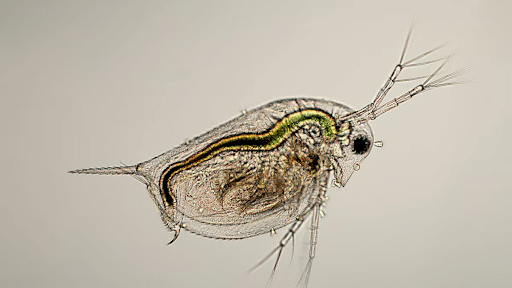The Humble – yet remarkable – Daphnia Pulex
Dear all
As well as having had our two Field Days, it’s also been Biology Enrichment Week, and my Thought for the Week attempted to link the two through the story of Daphnia Pulex (otherwise known as the humble, and tiny, water flea…). Her picture can be found to the right.
Their brains only have a few hundred neurons – a tiny fraction of the 86 billion in a human brain – yet, these simple creatures are capable of remarkable ingenuity. Most of the time, when food is plentiful and conditions are ideal, Daphnia reproduce asexually via a process called parthenogenesis. This involves female water fleas creating genetically identical offspring, which allows them to boost their population efficiently, without wasting energy and time trying to find a mate. This strategy makes sense when times are good
But when challenges hit – like dropping temperatures, falling water levels, or (most likely) the presence of predators who feed on the seemingly defenceless water fleas, Daphnia do something quite extraordinary: they start to produce male embryos and reproduce sexually. By doing so, they introduce genetic diversity, which is crucial for adapting and innovating when these things are needed. During these times, they also create hardy ‘resting eggs’ that survive harsh conditions. Perhaps most incredibly of all, however, they can instruct future generations to change their body shape through a process called cyclomorphosis. If you aren’t an expert in cyclomorphosis….this means that the water fleas use the chemicals secreted into the water by their predators to determine the future evolution of their offspring. Changes include developing a ‘helmet head’, an elongated body, or even ‘neck teeth’, all of which make them harder to eat by different predators. In other words, the insects that eat the water fleas give off chemical signals that are used to protect future ‘generations’ from those very predators. Quite remarkable for something that has a tiny fraction of our brain power.
What can we learn from these tiny, smart critters? Just as Daphnia embrace ‘new ideas’ (genetics) to adapt, we should always be on the lookout for how we can do the same. The author Steve Johnson, who features this story in his book ‘Were Good Ideas Come From’, talks about ideas as networks of connections, where thoughts collide and recombine, and often require the input from others (who might see things differently from us) to help take a concept from a thought to practical application.
Field Days often involve spending time in groups, trying to solve problems, sometimes with others whom you may not know very well. With that in mind, I encouraged our students to take their lead from the humble, but quite remarkable, Daphnia Pulex.
Have a great weekend and a lovely half-term break.
Best wishes
Michael Bond





